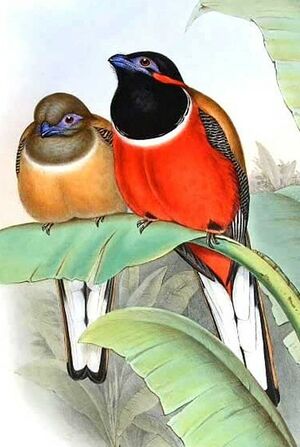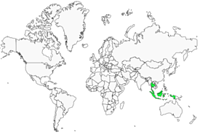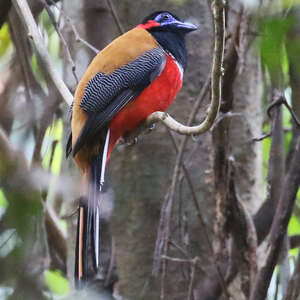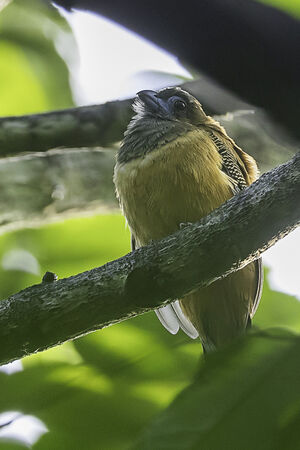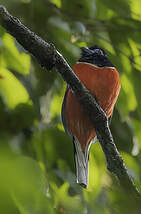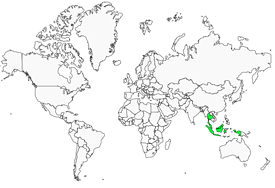Red-naped Trogon
Harpactes kasumba - Trogon à nuque rouge
Identification
Sir Thomas Stamford Raffles, a British military and naturalist (1781-1826), discovered the Red-naped Trogon in 1822, but if the character is interesting to us for his ornithological discovery, he is mostly known for founding Singapore in 1817. It should be noted that the scientific name of our Red-naped Trogon is Harpactes kasumba and, surprisingly, it adopts the Malay name of the trogon, which is kesumba. A large trogon (32 to 34 cm) with a distinct dimorphism, the forehead, crown, throat and chest are black, the bill is blue-cobalt with a black tip and is surrounded by very conspicuous black bristles; the large orbital circle is also blue-cobalt and surrounds the dark brown iris. The bird has a band of red feathers extending from its bill that encircles the neck and is unmistakable, the black chest being separated from the bright red abdominal area by a fine white band. The mantle, scapulars and back are ochre-yellow and the rump becomes brownish-red, as do the upper tail coverts, the black coverts are vermiculated with thin horizontal white waves and the black flight feathers show white margins. The central rectrices are brownish-red barred with black at the tip, the outer rectrices are white with a black base and show two black points directed downwards in the middle. The female is dressed in a brown-gray on the forehead, crown, nape and entire chest, the blue bill still has a black tip and a large blue orbital circle encircles the brown iris. A white band separates the chest from the yellow belly, the mantle, scapulars and back are brown, the rump and upper tail coverts becoming brownish-red. The dark brown coverts are vermiculated with yellow-ochre horizontal waves, the flight feathers are also dark brown and marked with white at the margins. The tarsi are blue-gray.Juveniles look like their mother, with a chest and belly tawny with white spots. Young males will start to have black on the throat and their stomach will show red patches. Two subspecies are recognized, ssp kasumba which gives its name to the species and ssp impavidus, similar to the nominal species but smaller, the female showing more grey on the throat. The two subspecies are poorly differentiated and hybridization may have or may have occurred in the past.
Subspecific information 2 subspecies
- Harpactes kasumba kasumba (Malay Pen. and Sumatra)
- Harpactes kasumba impavidus (Borneo)
Foreign names
- Trogon à nuque rouge,
- Trogón kasumba,
- republicano-de-nuca-vermelha,
- Rotnackentrogon,
- pirosnyakú malájtrogon,
- Roodnektrogon,
- Trogone nucarossa,
- rödnackad trogon,
- Rødnakketrogon,
- dravčík kasumba,
- trogon kasumba,
- Rødnakket Trogon,
- sepeltrogoni,
- trogon de clatell roig,
- sędzioł czarnoszyi,
- Краснозатылочный азиатский трогон,
- Luntur kasumba,
- アカエリキヌバネドリ,
- 红枕咬鹃,
- นกขุนแผนท้ายทอยแดง,
- 紅頸咬鵑,
Voice song and cries
The Red-naped Trogon gives five to six sharp kaup-kaup-kaup calls, the female having a higher and faster song. The song of the Red-naped Trogon is lower than that of its cousin, the Diard's Trogon, which shares the same range. It also gives a pew-pew-pew-pew, the first pew starting off high then lowering in tone and intensity. It will also emit a grasshopper-like chirp as an alarm call.
Habitat
The Red-naped Trogon can mostly be found in the humid primary forests, the dipterocarp forests of Malaysia and Indonesia with very tall trees; also present in thick secondary forests, bamboo forests and sometimes coconut plantations! The Red-naped Trogon is not a high-altitude trogon, it is primarily observed between 600 m and 1,200 m.
Behaviour character trait
The Red-naped Trogon is a resident species.
Dietfeeding habits
The Red-naped Trogon is primarily an insectivore, hunting a variety of insects from a branch or perch with a preference for stick-insects. Its diet is supplemented with fruits and seeds, and unfortunately knowledge about its dietary habits is very poor.
Reproduction nesting
Very little is known about the breeding of the Red-naped Trogon, a clutch was seen in July 1976 in the Malay Peninsula and immature birds spotted in June in Borneo. The nest is probably dug in an old rotten trunk, the clutch is probably two eggs, there is no other information about incubation time, rearing and feeding of the chicks yet.
Geographic range
Threats - protection
IUCN conservation status
concern
in the Wild
threatened
evaluated
Classified by Birdlife as Near Threatened (NT), the Red-naped Trogon is directly affected by the deforestation of the Sunda Islands where humans look for different precious woods. The usual crowd of human excesses comes every day to reduce its area of distribution: demographic explosion, pollution, intensive agriculture, chaotic tourism. This extraordinary Trogon survives only in few reserves and parks; Sir Thomas Stamford Raffles probably observed in 1822 one of the first Red-naped Trogons in what would become Singapore; the last documented specimen on this island, at the tip of the Malay peninsula, was seen in 1920! A century for a part of the species to disappear.
Sources of information
- IOC World Bird List (v14.1), Gill, F and D Donsker (Eds). 2024-04-18.
- A Natural history of the Trogonidae, Joseph M.Forshaw Albert Earl Gilbert
- Scientific Birds Names, James A.Jobling
- Vol. 6 - Handbook of the Birds of the World, Josep del Hoyo-Andrew Elliott-Jordi Sargatal
- xeno-canto, Sharing bird sounds from around the world,
- Avibase, Lepage Denis
- BirdLife International, BirdLife International
- HBW Alive,
- Oriental Bird Club,
- IUCN Red List of Threatened species,
- The internet Bird Collection,
- Wikipédia, Wikipedia, The Free Encyclopedia
Other sources of interest
 Specification sheet created on
02/08/2023 by Anne et Gabriel Leboff
Specification sheet created on
02/08/2023 by Anne et Gabriel LeboffTranslation by AI Oiseaux.net
published: 30-12-2013 - Updated: 23-03-2014
© 1996-2024 Oiseaux.net
- Accipitriformes
- Aegotheliformes
- Anseriformes
- Apodiformes
- Apterygiformes
- Bucerotiformes
- Caprimulgiformes
- Cariamiformes
- Casuariiformes
- Charadriiformes
- Ciconiiformes
- Coliiformes
- Columbiformes
- Coraciiformes
- Cuculiformes
- Eurypygiformes
- Falconiformes
- Galliformes
- Gaviiformes
- Gruiformes
- Leptosomiformes
- Mesitornithiformes
- Musophagiformes
- Nyctibiiformes
- Opisthocomiformes
- Otidiformes
- Passeriformes
- Pelecaniformes
- Phaethontiformes
- Phoenicopteriformes
- Piciformes
- Podargiformes
- Podicipediformes
- Procellariiformes
- Psittaciformes
- Pterocliformes
- Rheiformes
- Sphenisciformes
- Steatornithiformes
- Strigiformes
- Struthioniformes
- Suliformes
- Tinamiformes
- Trogoniformes

